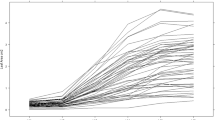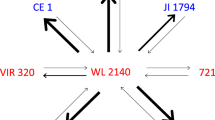Summary
TPS progenies from open-pollinated and 4x×2x crosses were compared on the basis of seed quality, seedling vigor, seedling tuber production and tuber yield. The hybrids from 4x×2x crosses were superior in all the traits. Even though the hybrid families may have these outstanding features, the relatively high cost of producing seeds can be a limitation to their widespread utilization in developing countries. Seeds from open pollination are much less expensive; their cost of production is only 10–20 % of that of hybrid seeds. Thus, the use of TPS families from open pollination may be an economical method for the production of potatoes from true seed until a suitable method of producing low-cost hybrid seed is available.
Zusammenfassung
Die Hauptgruppen von Kartoffelsamen-Familien (TPS, ‘true-potato-seed’) die für eine Kartoffelproduktion verwendbar erscheinen, sind: a) Hybriden von 4x×2x-, 2x×4x- und 2x×2x-Kreuzungen (Peloquin, 1982) sowie 4x×4x-Kreuzungen (Peloquin, 1979; Mendoza, 1979), b) offen bestäubende Nachkommenschaft. Diese beiden Gruppen von TPS-Nachkommenschaften haben deutlich unterschiedliche Eigenschaften im Hinblick auf ihre Eignung für die Kartoffelproduktion. Zweck dieser Studie war ein Vergleich zwischen TPS-Nachkommen einerseits und 4x×2x-Kreuzungen und offen bestäubenden andererseits auf der Basis von Saatqualität, Sämlingsvitalität, Sämlingsknollen-Produktion und Knollenertrag.
Zwei-und-fünfzig TPS-Familien, 35 von offen bestäubenden und 17 von 4x×2x-Kreuzungen wurden verwendet. Die Hybridfamilien entstanden aus Kreuzungen zwischen tetraploiden Klonen und 2x Phureja-haploiden Tuberosum-Hybriden mit der Fähigkeit zur Erzeugung von 2n-Pollen durch FDR. Mit wenigen Ausnahmen entstanden alle OP-Nachkommen aus denselben tetraploiden Eltern, die in den 4x×2x-Kreuzungen verwendet wurden. Sämtliche Samen- und Sämlingstests liefen im Laboratorium und im Gewächshaus. Die Sämlinge für die Feldversuche wurden im Gewächshaus angezogen und dann im Alter von etwa 6 Wochen in das Feld ausgepflanzt. Alle Ertragsversuche wurden mittels RCBD und 2 Wiederholungen durchgeführt.
Die Ergebnisse zeigen beträchtliche Unterschiede bei Samengrösse, Keimungsrate, Sämlings-Vitalität und Sämlings-Knollenproduktion zwischen den 4x×2x-Hybriden und OP-Nachkommen (Tabellen 1 und 2). Die Hybriden-Nachkommen waren bei allen diesen Merkmalen besser. Desweiteren erklären die mittleren Knollenerträge der beiden Gruppen von TPS-Familien die Überlegenheit der 4x×2x-Familien (Tabelle 3). Die Heterosis-Reaktion in den Nachkommen der 4x×2x-Kreuzungen wird auf der Basis der FDR-Weise für 2n-Pollenbildung erklärt. Bei diesem Mechanismus wird mehr als 80 Prozent der Heterozygotie der 2x-Eltern auf die Nachkommen übertragen.
Ungeachtet der noch ausstehenden Eigenschaften der Hybrid-Familien könnten die relativ hohen Kosten für die Hybridsaat-Produktion eine Begrenzung für eine verbreitete Verwendung in Entwicklungsländern bedeuten. Folglich kann die Verwendung von TPS-Familien von Offen-Bestäubenden eine ökonomische Methode für die Produktion von Kartoffeln aus Samen sein, bis eine brauchbare Methode zur kostengünstigen Produktion von Hybridsamen vorhanden ist.
Résumé
Les graines recherchées pour la production directe de pommes de terre proviennent des principaux types de familles suivants: a) les hybrides obtenus par croisément 4x×2x, 2x×4x, 2x×2x (Peloquin, 1982) et 4x×4x (Peloquin, 1979; Mendoza, 1979), b) les descendances issues de la pollinisation naturelle. Les lignées de ces deux groupes ont des caractéristiques distinctes sur le plan de leur aptitude à produire des pommes de terre. Le sujet de cette étude a été de comparer les descendances issues du croisement 4x×2x et celles provenant de la pollinisation naturelle, en se basant sur la qualité des semences, la vigueur germinative, la production de tubercules et le rendement en tubercules.
Cinquante-et-deux familles, dont 35 issues de pollinisation naturelle et 17 du croisement 4x×2x ont été utilisées. Ces dernières étaient obtenues par le croisement entre clônes tétraploïdes et des hybrides Phureja 2x×Tuberoseum haploïde capables de produire du pollen 2n. A quelques exceptions près, toutes les lignées issues de pollinisation naturelle étaient issus des mêmes parents tétraploïdes utilisés dans les croisements 4x×2x. Tous les tests sur graines et de germination étaient effectués en laboratoire et en serre. Les semences pour les essais au champ étaient réalisées en serre puis les plantes étaient transplantées dans le champ après six mois de croissance, selon un dispositif RCBD à 2 répétitions.
Les résultats obtenus montrent des différences importantes au niveau de la taille des graines, des pourcentages de germination, de la vigueur germinative et de la production de tubercules entre les hybrides 4x×2x et les lignées issues de pollinisation naturelle (tableaux 1 et 2). La descendance des hybrides étaient meilleure pour tous les caractères. Le rendement moyen en tubercules dans les deux groupes souligne la supériorité des familles de 4x×2x (tableau 3). Le comportement des lignées 4x×2x s'explique par le mode de formation du pollen 2n. Dans ce mécanisme, plus de 80 pour cent de l'hétérozygotie du parent 2x est transmis à la descendance.
En dépit des caractéristiques intéressantes des familles d'hybrides, leur coût relativement élevé peut être une limite à la diffusion dans les régions de grande culture. Par conséquent, l'utilisation de graines issues de pollinisation naturelle peut être économique pour la production de pomme de terre jusqu'à ce qu'une méthode de création d'hybrides moins onéreuse soit mise au point.
Similar content being viewed by others
References
Anonymous, 1981. Combining advantages of two growing methods. Circular, International Potato Center 9(11): 1–5.
Arndt, G. C., H. M. Kidane-Mariam, J. L. Rueda & S. J. Peloquin, 1985. Pollen fertility in relation to open pollinated true seed production.American Potato Journal (in press).
Li, J. H. & C. P. Shen, 1979. Production of marketable and seed potatoes from botanical seed in the People's Republic of China. International Potato Center Report of a Planning Conference on the production of potatoes from true seed. Manila, Philippines, p. 21–28.
Macaso-Khwaja, A. C. & S. J. Peloquin, 1983. Tuber yields of families from open pollinated and hybrid true potato seed.American Potato Journal 60: 645–651.
Mendoza, H. A., 1979. Preliminary results on yield and uniformity of potatoes grown from true seed. International Potato Center Report of a Planning Conference on the production of potatoes from true seed. Manila, Philippines, p. 156–172.
Mendiburu, A. O. & S. J. Peloquin, 1977. The significance of 2n gametes in potato breeding.Theoretical and Applied Genetics 49: 53–61.
Mok, D. W. S. & S. J. Peloquin, 1975. Breeding value of 2n pollen (diplandroids) in tetraploid×diploid crosses in potatoes.Theoretical and Applied Genetics 46: 307–314.
Peloquin, S. J., 1979. Breeding methods for achieving phenotypic uniformity. International Potato Center Report of a Planning Conference on the production of potatoes from true seed. Manila, Philippines, p. 151–155.
Peloquin, S. J., 1982. New approaches to breeding for the potato of the year 2000. In: W. J. Hooker (Ed.), Research for the potato in the year 2000. International Potato Center, Lima, Peru.
Rueda, J. L., 1983. Breeding methods for production of potatoes from true seed. M.S. Thesis, University of Wisconsin-Madison, 96 p.
Author information
Authors and Affiliations
Rights and permissions
About this article
Cite this article
Kidane-Mariam, H.M., Arndt, G.C., Macaso-Khwaja, A.C. et al. Comparisons between 4x×2x hybrid and open-pollinated true-potato-seed families. Potato Res 28, 35–42 (1985). https://doi.org/10.1007/BF02357568
Accepted:
Issue Date:
DOI: https://doi.org/10.1007/BF02357568




